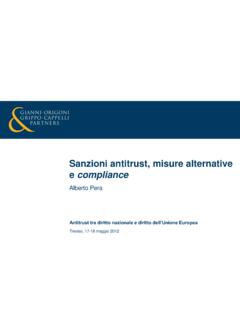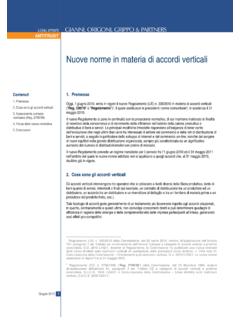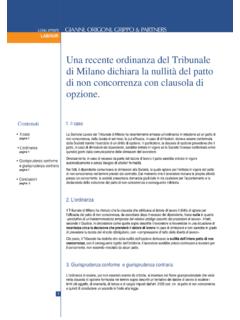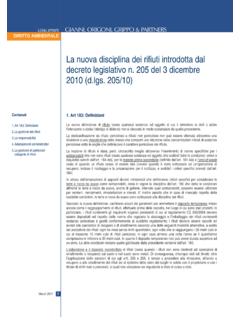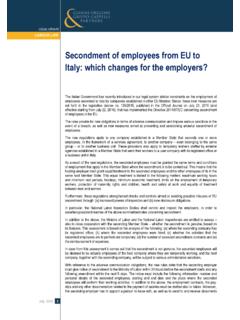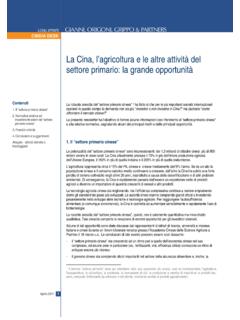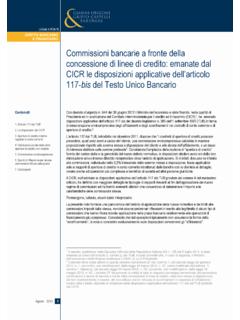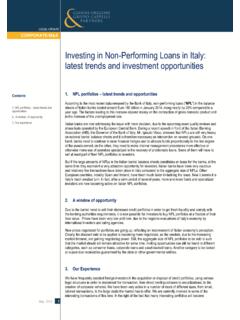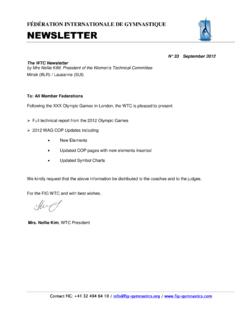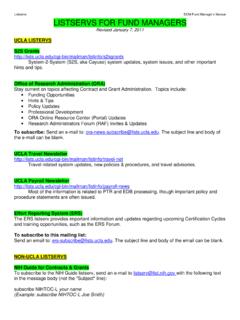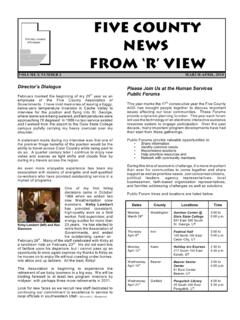Transcription of The Italian “resident non dom” regime - GOP.it
1 March 2017 1 TAXATION The Italian resident non-dom regime A Regulation of the Italian Tax Authorities Clarifies How the so-called resident non-domiciled regime in Italy Will Work On March 8, 2017, the Italian Tax Authorities ( ITA ) issued a regulation dealing with the practical aspects concerning the so-called Italian resident non-domiciled regime . 1. Main features of the regime The 2017 Budget Bill provides for a new tax regime ( New Tax regime ) somehow inspired by the UK resident non-domiciled regime although under Italian law there is no equivalent concept of domicile.
2 The purpose of the Bill is to attract new investors, in particular (U)HNW individuals. Taxpayers eligible for such an option must not have been tax resident in Italy for nine of the ten previous tax years ( Eligible Taxpayers ). The New Tax regime is optional and provides for a yearly substitutive tax ( Substitutive Tax ) on foreign sourced income derived, and on foreign assets held, by individuals who have transferred their fiscal residence in Italy. The amount of the Substitutive Tax is Euro 100,000 and it is reduced to Euro 25,000 for the Optional Taxpayers (as subsequently defined) who become tax resident in Italy.
3 The Substitutive Tax may not be offset by income taxes suffered abroad on the foreign sourced income. An exception driven by anti-avoidance purposes concerns the sale of qualified participations ( a participation in the capital of a listed company higher than 2% or higher than 20% in case of non-listed company) occurring within the period of five years starting from the year in which the taxpayer qualifies as Italian tax resident . In addition, the taxpayers may opt not to apply the Substitutive Tax with respect to the foreign income sourced in a designated jurisdiction.
4 In such a case, the ordinary Italian income tax liability arising on that income may be offset by the relevant foreign tax credit. Unlike the UK regime , it is irrelevant as to whether or not the (new) Italian taxpayers remit their income in Italy; the special regime at hand would in any case apply. The option is revocable and may not last for more than 15 years. In case of election, the Italian gift and estate tax does not apply with respect to the assets held, and the rights existing, abroad. Those who elected for the New Tax regime ( Active Eligible Taxpayers ) are not subject to the reporting obligation on foreign assets and income.
5 Upon transfer of the tax residence in Italy and election for the special regime , the Active Eligible Taxpayers as well as the Active Optional Taxpayers (as subsequently defined) must inform the ITA about his/her previous State of residence and the ITA shall have to inform such State that the taxpayer has transferred his/her tax residence in Italy. The New Tax regime is matched by changes to Italian immigration laws. On the premise that non-EU natural persons invest in Italy such amendments are aimed at to make possible for non EU natural persons to avoid the ordinary applicable restrictions for the acquisition of Italian residency.
6 Contents: 1. Main features of the regime 2. How to opt for the regime 3. Optional eligible taxpayers 4. Termination, expiration and withdrawal March 2017 2 A non-EU citizen may obtain an investor visa on condition that he/she invests, and maintains that investment for at least 2 years, either Euro 2 million in Italian Governmental bonds or Euro 1 million in securities issued by a company based and actually operating in Italy. The investor visa can also be obtained by making a donation of at least Euro 1 million to a project in sectors of public interest such as culture, education, handling of immigration and scientific research.
7 In addition to fulfilling the investment requirement, an applicant for an investor visa will also be required to prove that he/she has sufficient financial resources to support himself/herself during the planned stay in Italy. The investor visa has an initial term of two years and, under certain conditions, it will be possible to obtain extensions of 3 years each. Family members of the investor will be entitled to a family connection visa allowing residence with the investor. 2. How to opt for the regime The eligible taxpayer may opt for the regime upon: a.
8 Submission of the income tax return for the fiscal year in which he/she acquired the tax residence in Italy ( First Applicable Taxable Year ); or b. submission of the income tax return for to the fiscal year subsequent to the First Applicable Taxable Year ( Second Applicable Taxable Year ). Alternatively, the Eligible Taxpayer may file a specific ruling request with the ITA reporting the following: a. his/her personal data including his/her Italian tax identification number ( TIN ); b. that he/she has not been tax resident in Italy for nine of the ten previous fiscal years; c.
9 The jurisdiction(s) in which he/she has been tax resident in the fiscal year preceding that of the exercise of the option; d. the jurisdiction(s) that he/she does not want to be covered by the Substitutive Tax ( Excluded Jurisdictions ). In such a case, income sourced in such jurisdictions would be ordinarily taxable in Italy and the taxpayer would be accorded the foreign tax credit. Over the course of the years, the taxpayer may enlarge the number of Excluded Jurisdictions. In the ruling request the Eligible Taxpayer must report conditions that enable him/her to opt for the New Tax regime .
10 The option is automatically renewed every year, unless one of the conditions reported in paragraph 4 below occurs. 3. Optional eligible taxpayers The Eligible Taxpayer may extend the application New Tax regime to some selected individual(s) that have a close relationship with him/her ( Optional Taxpayers ). The Optional Taxpayers are: a. Spouse; b. Son(s) and daughter(s) and in case of their death, their descendants; c. Parents and in case of their death, their ascendants; d. Son-in-law and daughter-in-law; e. Father-in-law and mother-in-law; f. Brothers and sisters.
